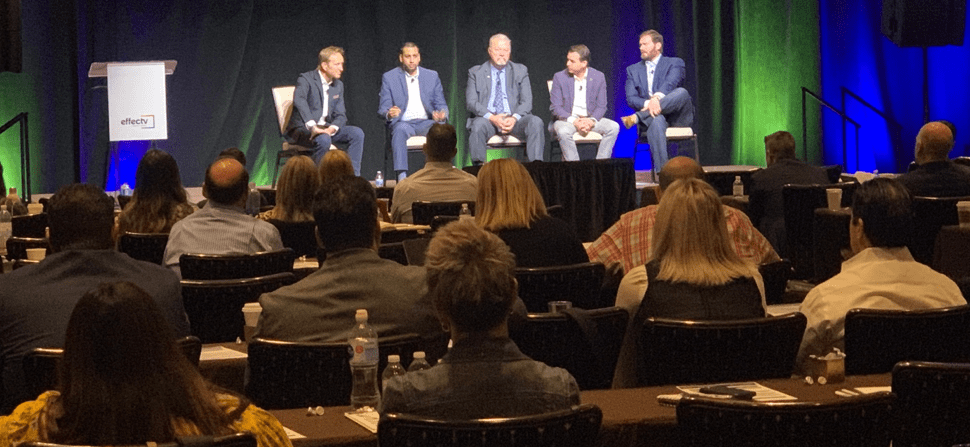Ahead of the NADA conference in Las Vegas, automotive advertising professionals—including Jake Rostollan, executive vice president at Pinnacle Advertising and Neil Gandhi, vice president of marketing at Faulkner Auto Group—shared their insights into advanced advertising, the next generation of car buyers, and alternative fuel vehicles, all of which will likely have a significant impact on the future of the automotive sector.
Four members of Effectv’s Automotive Advisory Council participated in a panel discussion to dive deeper into these topics at a time when the automotive industry faces widespread disruption and change. To compete, automotive marketers are being tasked with staying progressive and attuned to advanced advertising tactics and opportunities, while at the same time simplifying marketing messages to communicate a dealership’s value.

The abundance of advertising choices and players in the space is creating confusion, but automotive marketers are sure about one thing: activating reliable, clean data is key. “First-party data from companies like Effectv, combined with third-party data can assist dealers tremendously,” says Gandhi. The databases (CRM, DMS) a dealership brings to the table comprise “the secret sauce” that helps drive TV and digital campaigns with the most efficiency.
Reaching the elusive millennial and younger audience is top of mind for dealers, as well. And the myth that those ages 38 and younger don’t buy cars (and heavily rely on ridesharing services) couldn’t be further from the truth. David Regn, co-founder of Stream Companies, an agency that has more than 400 dealerships on its client roster, sees huge opportunity with this audience.
“If you look at the five-year trend, specific to millennials and where they are in their lifecycle, I think they’re going to be buying cars at rates that we’ve potentially never seen before, driving car sales up in the coming years,” says Regn. New vehicle sales are expected to remain relatively constant according to research by IHS Markit, with a predicted $16.5 million average expected now through 2023.1 The market could benefit from Regn’s optimism.
With the opportunity for millennials to purchase new and used vehicles in higher numbers—and Gen Z not too far behind—it could be true they’ll be the ones adding to the adoption of alternative fuel vehicles. For Gandhi and the Faulkner organization, Volvo is one to watch as “in 2022, [the brand] is expected to end the product lifecycle for gasoline-only vehicles.” Just last year, all-electric Tesla ranked eighth among luxury brands. Now, it’s in the top five with the likes of Lexus and BMW, showing a massive year-over-year growth of 18.2 percent.2
While dealers’ eyes are on the growth of alternative fuel vehicles, for Paul Nygaard, senior vice president of marketing at Larry H. Miller Dealership Group, Hyundai is the one to watch. The brand has taken a slow and steady approach to adopting electric; however, “they’ve got five SUVs—that’s what people are buying—their sedan business is strong, and they’re doing the right thing in electrification.”
There’s opportunity abound with aging millennials, alternative fuel vehicles becoming mainstream, and advanced advertising tactics. Increased dealership foot traffic (in-store and online) is a high priority for auto marketers who prioritize efficiency in their marketing mix. There are many factors that drive the sale of a car, but maximizing those opportunities to sell is the goal for all marketing activity. Ultimately, it comes down to the consumer, says Rostollan, but “anywhere we’re seeing a demonstrable action that they’re taking and can measure to show that our advertising tactics are moving them towards buying a car is successful marketing.”
About the Effectv Automotive Advisory Council:
Founded in 2018, the mission of the Automotive Advisory Council is to represent automotive marketers’ interests in relation to Effectv’s advanced advertising products and tools, as well as broader industry trends and insights. The AAC is an advocacy group, comprised of tier 2-3 auto leaders from agencies, dealers and manufacturers. The AAC operates as an educational and organizing resource to assist marketers in reaching desired audiences in premium video environments, conducting research documenting the benefits of cable advertising, and championing the interests of member automotive marketers and the industry.
Sources: 1-2: IHS Markit 19 Takeaways From ’19 (Thomas Libby)








